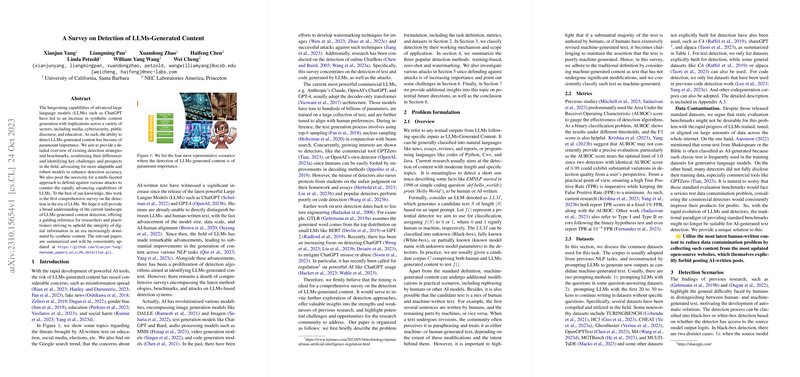An Analytical Overview of LLM-Generated Content Detection
In recent years, the proliferation of advanced LLMs, such as ChatGPT and GPT-4, has elevated the capability of machines to generate text that closely mimics human-written content. This progress, while offering remarkable advancements across various sectors like media, cybersecurity, and education, has also posed significant challenges, necessitating robust methods for detecting synthetic content. The paper "A Survey on Detection of LLMs-Generated Content" by Xianjun Yang et al. presents a comprehensive survey of state-of-the-art detection methodologies, highlighting the myriad challenges and suggesting future directions for research in this critical area.
Overview and Core Contributions
The paper endeavors to offer an exhaustive overview of existing detection strategies for LLM-generated content, benchmarking various approaches and illustrating the nuances of their functionalities. It distinctly categorizes the detection methodologies into three main classes: training-based methods, zero-shot methods, and watermarking techniques. Each category is meticulously analyzed within different operational scenarios—ranging from black-box to white-box detection—to reflect the practical realities faced by researchers and developers in this domain.
Key Findings and Methodologies
1. Training-based Methods:
These methods involve the use of classifiers trained on collected binary datasets, where the detectors are fine-tuned on both human and AI-generated text distributions. The paper highlights the increasing interest in detecting high-quality text from LLMs, citing approaches like OpenAI's own text classifier and GPTZero, which utilize mixed sources and decoding strategies to enhance robustness.
2. Zero-shot Methods:
Featuring prominently in the discourse on adaptability, zero-shot detectors leverage intrinsic properties of LLMs for detection without requiring extensive training data. Noteworthy approaches like DNA-GPT and DetectGPT demonstrate how probability divergence and sample perturbations can facilitate effective detection. This category underscores the importance of adaptability in response to dynamically evolving LLM architectures.
3. Watermarking Techniques:
The paper elaborates on watermarking as a strategic solution, embedding identifiable patterns within generated text to ascertain origin. The review encompasses both traditional watermarking methods and novel training-free techniques like soft watermarking, which manipulates sampling processes without degrading text quality.
Numerical Results and Implications
The paper provides a detailed comptline of various datasets utilized for detection tasks, including TURINGBENCH and M4, emphasizing their pivotal role in evaluating detection methods. The effectiveness of each detection technique is juxtaposed against these datasets, showcasing metrics like AUROC scores and True Positive Rates at fixed False Positive Rates. This rigorous analysis yields a nuanced understanding of detection efficacy under varied conditions and points to the necessity for multi-faceted models capable of generalizing across different model families and attack vectors.
Challenges and Future Directions
The paper identifies several critical challenges that impede progress in this domain. Among them, overcoming adversarial attacks and paraphrasing remain paramount, as these can significantly destabilize detector performance. Furthermore, the challenge of detecting LLM-generated code—a task distinct from natural language detection due to variable entropy and text length—requires special attention to realize robust solutions.
Moving forward, the authors suggest that refining detection methodologies to improve scalability, robustness to novel LLM updates, and generalization to unseen data distributions are essential. Moreover, enhancing the explainability of detection decisions and developing standardized benchmarks to measure detector effectiveness are pivotal areas for future exploration.
Conclusion
In essence, the survey by Yang et al. is a timely and well-articulated compendium of the current landscape in LLM-generated content detection. It underscores the pressing need for innovative and scalable solutions in this rapidly evolving field. As LLMs continue to advance, the ability to discern machine-generated content with precision will be integral to maintaining the integrity of digital information and addressing ethical concerns associated with LLM usage. Researchers and practitioners are thus presented with a roadmap, built on a foundation of comprehensive analysis, to guide future endeavors in this indispensable scientific pursuit.
